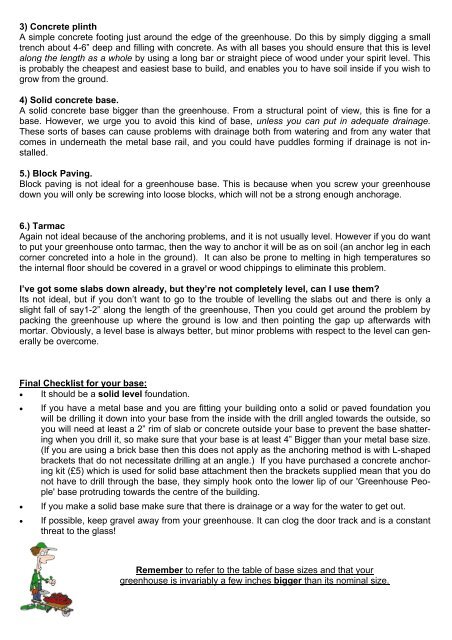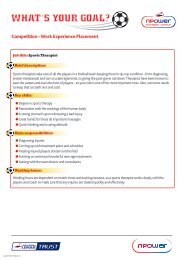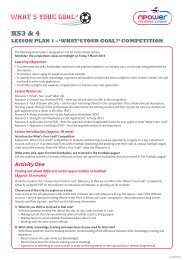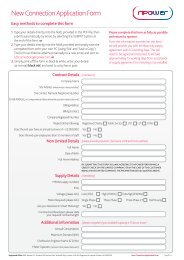Extra Information And Advice Booklet. Read Me Before ... - Npower
Extra Information And Advice Booklet. Read Me Before ... - Npower
Extra Information And Advice Booklet. Read Me Before ... - Npower
- No tags were found...
You also want an ePaper? Increase the reach of your titles
YUMPU automatically turns print PDFs into web optimized ePapers that Google loves.
3) Concrete plinthA simple concrete footing just around the edge of the greenhouse. Do this by simply digging a smalltrench about 4-6” deep and filling with concrete. As with all bases you should ensure that this is levelalong the length as a whole by using a long bar or straight piece of wood under your spirit level. Thisis probably the cheapest and easiest base to build, and enables you to have soil inside if you wish togrow from the ground.4) Solid concrete base.A solid concrete base bigger than the greenhouse. From a structural point of view, this is fine for abase. However, we urge you to avoid this kind of base, unless you can put in adequate drainage.These sorts of bases can cause problems with drainage both from watering and from any water thatcomes in underneath the metal base rail, and you could have puddles forming if drainage is not installed.5.) Block Paving.Block paving is not ideal for a greenhouse base. This is because when you screw your greenhousedown you will only be screwing into loose blocks, which will not be a strong enough anchorage.6.) TarmacAgain not ideal because of the anchoring problems, and it is not usually level. However if you do wantto put your greenhouse onto tarmac, then the way to anchor it will be as on soil (an anchor leg in eachcorner concreted into a hole in the ground). It can also be prone to melting in high temperatures sothe internal floor should be covered in a gravel or wood chippings to eliminate this problem.I’ve got some slabs down already, but they’re not completely level, can I use them?Its not ideal, but if you don’t want to go to the trouble of levelling the slabs out and there is only aslight fall of say1-2” along the length of the greenhouse, Then you could get around the problem bypacking the greenhouse up where the ground is low and then pointing the gap up afterwards withmortar. Obviously, a level base is always better, but minor problems with respect to the level can generallybe overcome.Final Checklist for your base:• It should be a solid level foundation.• If you have a metal base and you are fitting your building onto a solid or paved foundation youwill be drilling it down into your base from the inside with the drill angled towards the outside, soyou will need at least a 2” rim of slab or concrete outside your base to prevent the base shatteringwhen you drill it, so make sure that your base is at least 4” Bigger than your metal base size.(If you are using a brick base then this does not apply as the anchoring method is with L-shapedbrackets that do not necessitate drilling at an angle.) If you have purchased a concrete anchoringkit (£5) which is used for solid base attachment then the brackets supplied mean that you donot have to drill through the base, they simply hook onto the lower lip of our 'Greenhouse People'base protruding towards the centre of the building.• If you make a solid base make sure that there is drainage or a way for the water to get out.• If possible, keep gravel away from your greenhouse. It can clog the door track and is a constantthreat to the glass!Remember to refer to the table of base sizes and that yourgreenhouse is invariably a few inches bigger than its nominal size.
















